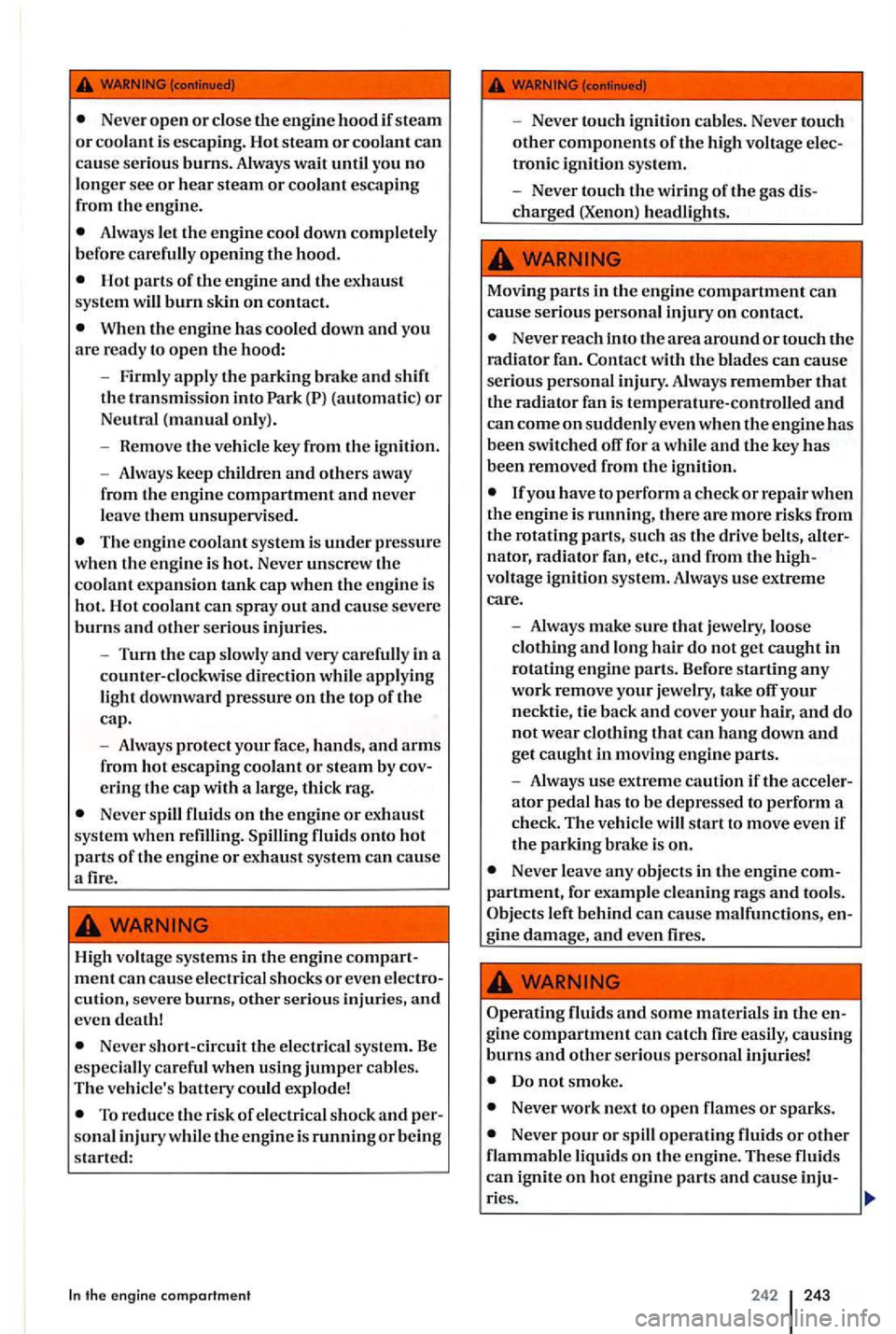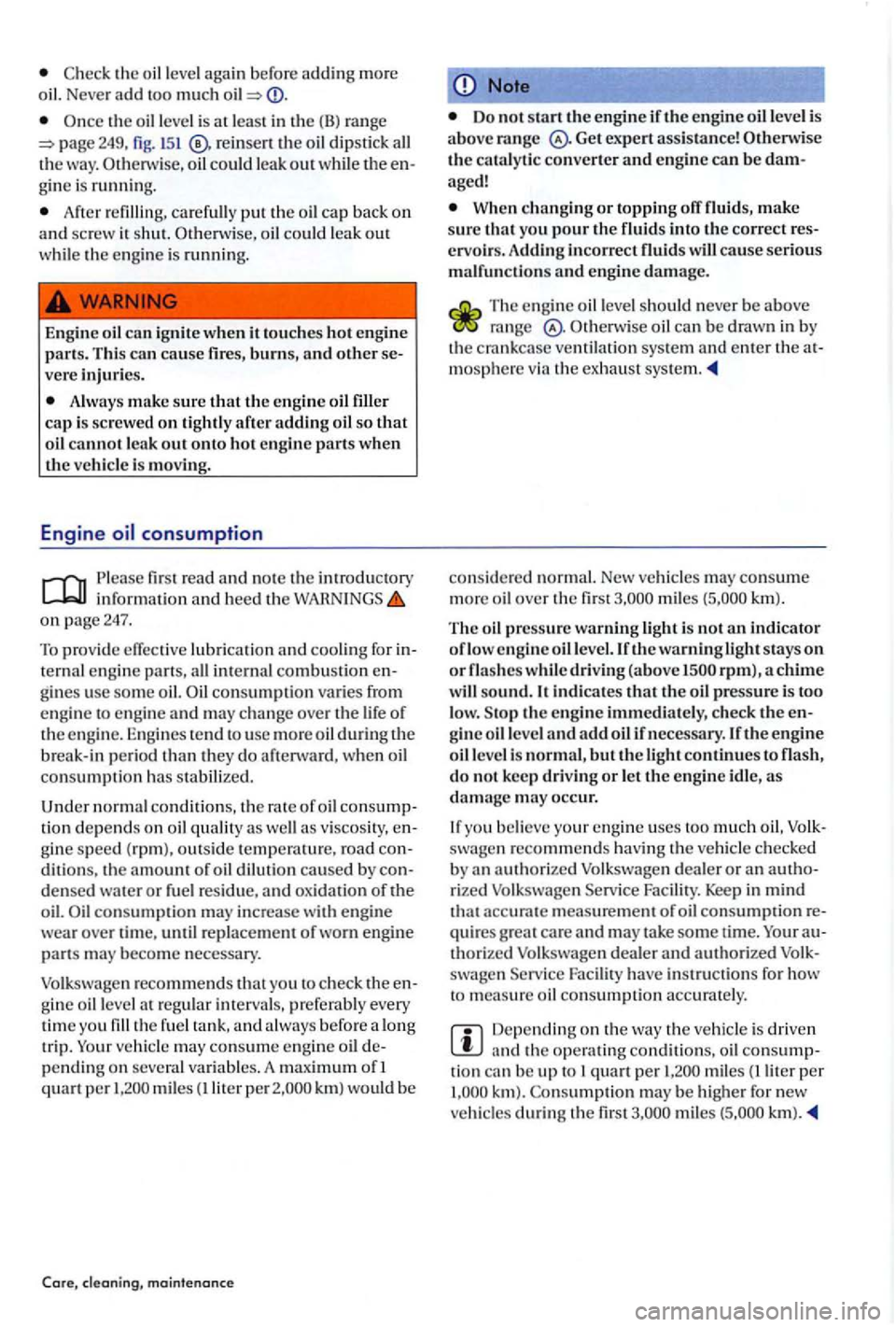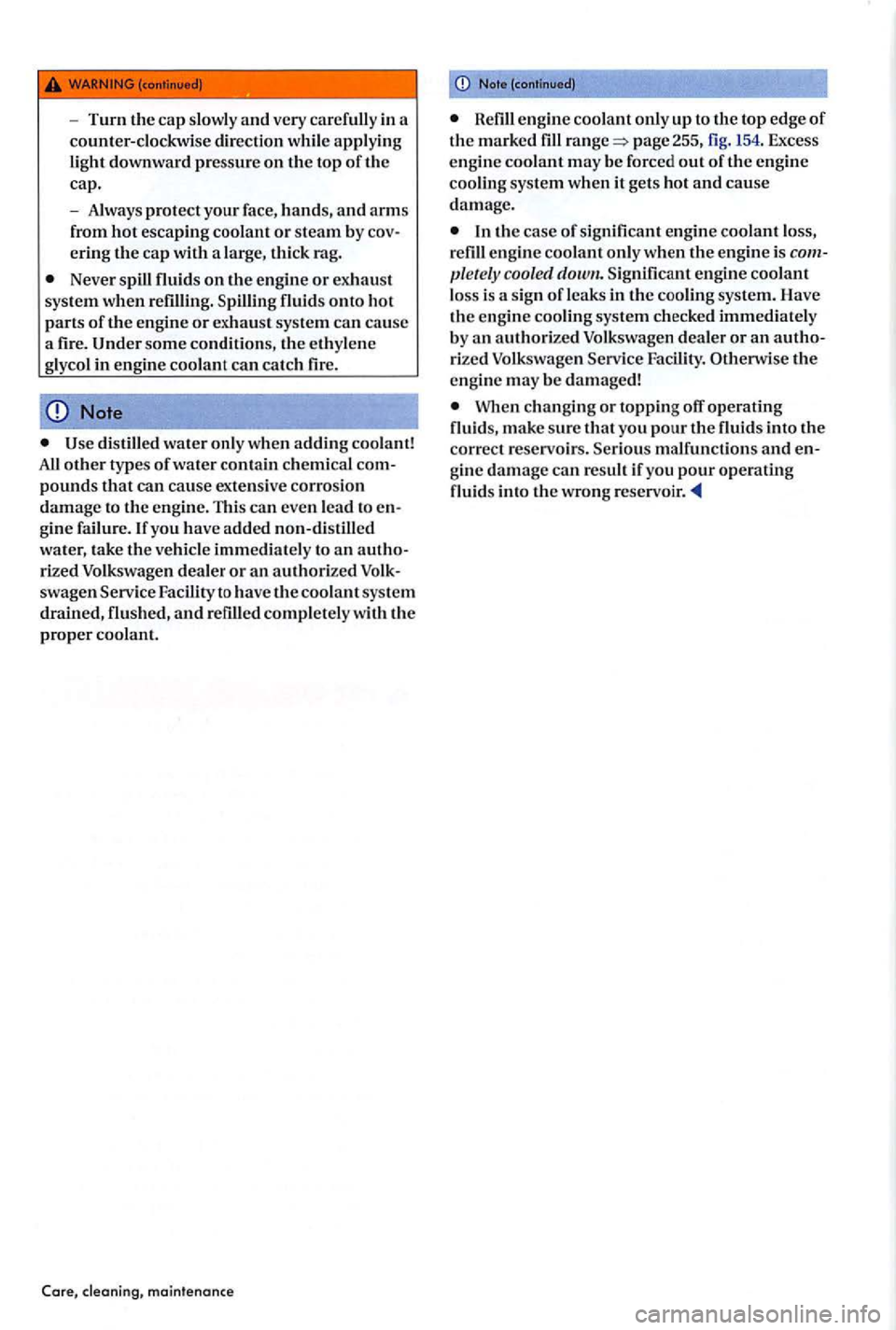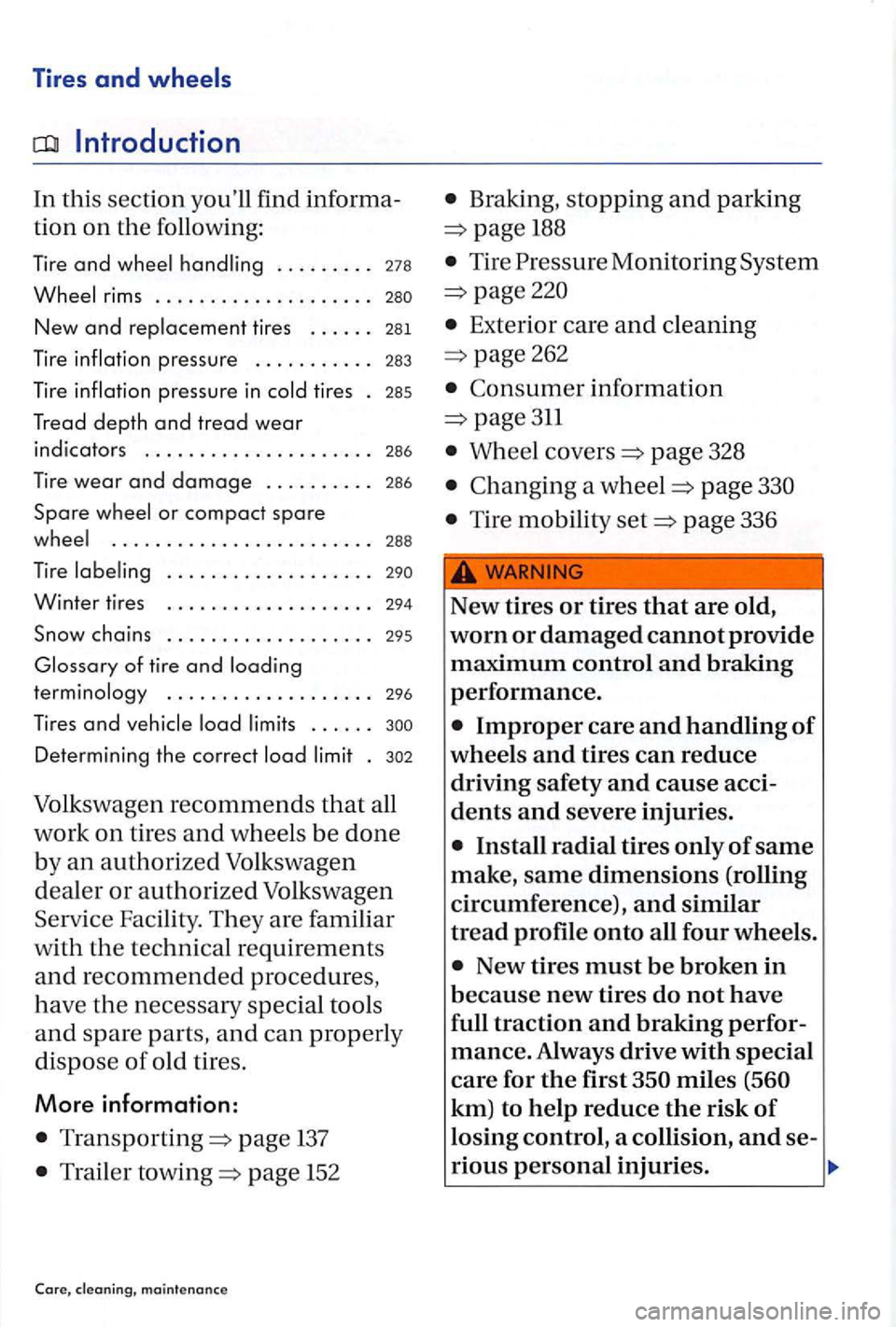2012 VOLKSWAGEN GOLF PLUS Pressure
[x] Cancel search: PressurePage 240 of 541

Never open or close the engine hood if steam or coolant is escaping. Hot steam or coolant can cause serious burns. Always wait until you no longer sec or hear steam or coolant escaping
from the engine.
Hot parts of the engine and the exhaust
system will burn skin on contact.
When the engine has cooled down and you are ready to open the hood:
- Firmly
apply the parking brake and shift the transmission into Park
The engine coolant system is under pressure when the engine is hot. Never unscrew the coolant expansion tank cap when the engine is
hot. Hot coolant can spray out and cause severe burns and other serious injuries.
- Turn
the cap slow ly and very carefully in a
counter-clockwise direction while applying
light downward pressure on the top of the cap.
- A
lways protect your face, hands, and arms from hot escaping coolant or steam by
Never spill fluids on the engine or exhaust
system when Spilling fluids onto hot parts of the engine or exhaust system can cause a fire.
High voltage systems in the
engine com ment can cause electrical shocks or even
Never short-circuit the electrical system. Be especially careful when using jumper cables. The vehicle's battery could explode!
To reduce the risk of electrical shock and sonal injury while the engine is running or being started:
the engine compartment
- Never touch ignition cables. Never touch other components of the high voltage tronic ignition system.
- Never touch
the wiring of the gas
Never reach into t11e area around or touch the
radia tor fan. Contact with the blades can cause serious personal injury. Always remember that the radiator fan is temperature-controlled and can come on suddenly even when the engine has been switched for a while and the key has been removed from the ignition.
lfyou have to perform a check or repair when the engi ne is running, there are more risks from tl1e rotating parts, such as the drive belts, nator, radiator fan, etc ., and from voltage ignition system. Always use extreme care.
- Always make
sure that jewelry, loose clothing and long hair do not get caught in rotating engine parts. Before starting any work remove your je welry, take
parking brake is on.
Never leave any objects in the engine
left behind can cause malfunctions,
Do not smoke.
Never work next to open flames or sparks.
Never pour or spill operating fluids or other flammable liquids on the engine. These fluids can ignite on hot en g in e parts and cause ries .
242 243
Page 243 of 541

first r ea d and note th e int roduc tory information and h ee d th e on page242 .
Opening the engine hood
Befo re you open th e hood, make sure that the
w ind shi eld wiper arm s are res tin g on the w ind
fig. 14 9 . The engine hood is re
l ease d from its latc h by a
the seco ndary hoo d rele ase leve r fig. (arrow) and
th e hoo d dow n to overcome the res ista nce of th e g as-pressure
L et th e engine hood drop into th e hood latch do not press on it afterw ard!
If th e hoo d do es not close compl ete ly, o pe n it aga in and close it properly.
W h
en the ho od is properly clo sed, you ca n see that
it fits flu sh with th e oth er bod y parts. The indi cato r
light in the instrument clu ster will go out
Secondary hood release in th e radia tor
grille .
If
the h ood is not clos ed properly , it could fly up and block your view while you are driving. This can lead to a crash and serious pe rs onal injuries.
After clo sing the e n gine hood, ch eck that the hood releas e le ver is properly l a tc hed into the hood lat ch. The engine hood must be flush with the surrounding auto body parts.
If you ever notic e that tl1e hood latch is not properl y secu re d when the vehicl e is moving,
s top at once and close it.
Nev er le t anyone get in the way of the hood when closing it.
N ote
Make sure the windshield wiper arms are
resting on the winds hi eld before you open tJ1e hood. Otherwi se, the windshield wipers and the hood may be damaged.
Always put the windshield wiper arms down against the windshield before driving the vehicle.
Page 247 of 541

the oil leve l agai n befo re addin g more
oil. Never add much
O nce th e oil leve l is at least in the ( B) ra nge
oil dip stick all th e way. oil could le ak out while th e en
g in e is running.
Afte r r efilling, car efully put the oil ca p back on and scre w it shut. Oth erwi se, oil could leak out whi le th e e ngine is running.
E ngin e oi l ca n ignite
when it tou ches hot e n g ine parts. T hi s can ca use fires, burns, and other severe injuri es.
Always make sure that the engin e oil fill er cap is screwed on tightly afte r adding oil so that oil cannot leak out ont o hot engin e parts whe n
th e vehicle is moving .
Engine
first r ea d and no te th e introductory information and h eed o n pa ge 247.
To prov ide effective lubricatio n and coolin g for in
ternal engine parts, all internal combustio n en
g ines use some oil. consumption varies from
e ng in e to engi ne and may ch an ge ove r th e life of th e e ng in e. Engi nes te nd to use m ore oil during th e
br eak- in peri od th an they do afterwa rd, when oil
co nsumption has s ta bili zed.
rat e of oil consump
tion dep e nd s on oil quality a s well as v isc osity, e n
g in e s pee d (rpm), outs ide tempe rature, road condit io ns, the amount o f oil dilution caused b y condensed water o r fuel residue, and oxidation of th e
o il. consumptio n may in crease with eng in e
wea r ove r time, until re pla cement of worn eng ine part s may beco me necessary .
Volk swage n recommends th at yo u to c heck the engin e oil leve l
vehicl e may consum e engine oil d epending o n seve ral var iables. A maximum of I quart per miles (!lite r km ) would be
Care, maintenance
Note
D o not start the engine if lhe e ngine oil leve l is
above range expert ass is ta n ce! Otl1envise the ca talytic con verter and engine ca n be dam
aged!
W hen changin g or topping ofT make sure that you pour the into the correct reservoir s. Addi ng incorrec t
The e ngine oil leve l s h o uld never be above ran ge oil ca n be drawn in by
th e cra nkcase ventilation syste m and ent er th e at
mo sphere via th e e xh au st sys te m .
co nside red normal. New vehicles may consume
m ore oil over th e km).
T he oi l pressure warning light is not an indicator oflowe ng in e oillevel.lfthe warning light stays on or whil e d rivin g (above rpm), a chime
will sound. It indica tes that the oil pressure is too
low. th e engine immediately, check the engine oil leve l and add oil if n ecessary . If the engine oil leve l is normal , but the continues to do not kee p driving or let t11e e ngin e idl e, as damage may occur.
If you believe your en g in e uses to o much oil, Volkswagen recommends havin g th e vehicle checked b y an auth orized Volkswagen dea le r or an ri ze d Volk swagen Service Facility. Keep in mind that accurate measurem ent of oi l consumption requires great ca re and m ay take som e time. au
t h orized Volkswa gen d ea ler and a uthorized Volk
s wa gen Facility have instru ctions for how to m eas ure oi l co nsumptio n acc ura te ly.
Dep e ndin g on the wa y th e ve hicl e is dri ven an d th e ope ratin g conditions, oil consump
t ion can be up to I quart per mil es (!liter per
Page 252 of 541

read and note the introductory
on page 252.
If th e coolant level drops too low, the engin e
coo lant level/ tempe ratur e warni ng ligh t lights up.
Park the ve hicl e on level ground.
Always let the engin e cool
th e engine hood
There is a fig.
When the eng in e is co ld, check the e ngine
coolant leve l relat ive to th e marking on th e sid e of th e expa nsio n tank fig. 154.
Always protec t face, hands and arms from h ot
escaping coo lant o r steam by cover ing the cap with a larg e, thi ck rag.
Carefully unsc rew the
Add new engine co olant ac co rding to Volkswagen specifications page 254)
Th e engi ne coo lant leve l must b e in sid e the mark s on the sid e of the 154. Do
not above top edge of the
the engine compartment
Fig. 155 Coolan t e xpans ion tank cap in the eng in e
compartment.
Screw the lid tightly.
Even in a n em erge ncy, do not use any other kind of coolant addi tive if eng ine coolant meeting
Volkswagen pa ge 254) is una v ail
able! Instead, add distilled water
page 254.
H
ot steam and hot engin e coo lant can cause se
rio us burns.
Never open the hood if yo u sec steam o r coolant esca ping from the engine compartment. Always wait until you no longer see or hear steam or coolant escapin g from the engine.
Always let the e ngin e cool down compl etel y
before carefully opening th e hood.
When the engin e has coo le d down and you are ready to open hood:
- F
irmly apply the parking brake and shift (automatic) o r Neutral (manual only).
- Hemov e
the vehicl e key from the ignition.
- Always keep c
hildren and others away from the en gin e compartment and never
leave them unsupervise d.
The engine coolant system is under pressure
w hen the engine is hot. Neve r unscrew the coolant expansion tank cap whe n the engine is hot. Hot coolant can spray out and ca use severe burns and other serious injuri es.
254 255
Page 253 of 541

-Turn the cap slowly and ve ry ca re full y in a
counte r- clo ckwise dir ect.ion whil e appl yin g light downwa rd pressure o n the top of th e cap.
-
Always prot ect your face, h ands, an d a rms
f ro m hot escaping co olant o r steam b y ering the ca p with a la rge, thick ra g.
Never spill fluid s on th e e ng in e o r exhaust
sys te m when refi lling . fluid s ont o ho t
p ar ts of the e ng ine or exhaust syste m can cause a fire. some conditio ns, the eth yle ne
g lycol in en gin e cool an t catc h fir e.
Note
di still ed wa te r onl y when adding coo lant! All othe r types of wa te r contain ch e m ica l pounds that can ca use exte nsive cor rosio n
damag e to the e ngin e. Th is can eve n lead to
ri zed Volkswa ge n deale r or an authorize d to have th e coo lant sys te m
d rai ned , flu sh ed , and refille d compl ete ly w ith the
p ro per co olant.
m aintenance
Note (co ntinue d !
Refill eng in e cool ant only up to th e to p edge o f the m arke d fill range=> p age 255, fig. 154 . Excess
e ng in e coolan t m ay be forced out of th e e ng in e
co olin g sys te m when it ge ts ho t and cau se
d am age.
engi ne coo lant o nl y wh en the e ng in e is coole d Sig n ifica nt engin e cool ant loss is a s ig n of leak s in the cooling sys te m. Have
th e e ng in e coo ling syste m ch ecke d immedi ate ly
b y a n authorize d Volkswage n deale r or an ri ze d Volkswage n
When ch an gin g o r top pin g off ope ratin g
fluid s, make sure tha t yo u pour the fluid s int o th e
correc t reservoi rs. ma lfunctio n s and gine da m age can result if yo u p ou r operating fluid s int o the wro ng
Page 273 of 541

Tires and wheels
Introduction
In this section you'll find informa
tion on th e following:
Tire and . . . . . . . . . 278
New and tires . . . . . . 281
Tire
tires . 285
Tread depth and tread wear
indicators . . . . . . . . . . . . . . . . . . . . . 286
Tir e wear and damage . . . . . . . . . . 286
Spare or compact spare
....... ................. 288
Braking, stopping and parking
188
Tire Pressure Monitoring System
Exterior care and cleaning
page262
Consume r information
Wheel covers page 328
Changing a wheel page
T ir e mobili ty page 336
Tire ...................
Winter tires . . . . . . . . . . . . . . . . . . . 29 4
Snow chains . . . . . . . . . . . . . . . . . . . 295
of tire and
. . . . . . . . . . . . . . . . . . . 296
Tires and . . . . . .
Determi ning the correc t
page 137
Trailer towing page 152
Core, maintenance
New tires or tires that are old,
worn or damaged cannot provide
maximum control and braking
performance.
New tires must be broken in
because new tires do not have
full traction and braking perfor
mance. Always drive with special
care for the first
Page 274 of 541

(contin ued )
tire inflation pressure
regularly when
the tires are cold
and always maintain the pre
scribed tire pressure .
Low tire
pressure
can cause tires to get too
hot, resulting in
tread separation,
sudden loss of pressure , and
blowouts . This is because tires
with excess ively low pressure
un
dergo more flexing, which can
cause the tire to overheat and de
stroy
the tire.
Never exceed the permissible
maximum speed
and load rating
of the tires on your vehicle.
The effectiveness of the driver
assistance systems
and the brak
ing
support systems depends
on the tire traction.
care and maintenance
To reduce the risk of losing
control,
crashes and serious per
sonal injuries, never loosen the
bolts on wheels with bolted rim
rings.
Never mount used tires on
your vehicle if you are not sure of
their past use.
Tires age even if they are not
being used and can fail suddenly,
especially
at high speeds,
causing loss of vehicle control,
accidents,
and severe personal
injuries. Tires that are more than
6 years old can be used only in an
emergency and then only with
special care and at low speed.
For technical reasons it is usu-
ally
not possible to use wheel
rims from other vehicles. Even
wh eel rims from
the same model
may not fit properly.
Fac ility if necessa1y.
276
Page 275 of 541

Tire and wheel handling
Fig. 160 Tire rotation diagram.
and note the
mtroductory mformation
and heed the WARNINGS on
page 276.
Tires may be the least appreciated
and most abused parts of a motor
vehicle. Tires are very important,
since their small patches of rubber
are the only contact between your
vehicle and the road.
Maintaining
correct tire pressure,
making sure that your vehicle and
its tires do not have to carry more
weight than they can safe ly
handle, and regularly inspecting
tires for damage (such as cuts,
s la sh es, irregular
wear, and overall
condition) are the
most important
things that you can do to help
avoid
sudden tire failure , in
cluding tread separation and
blowout.
The tires and wheels are essential
parts of the vehicl e's design. The
tires and wheels approved by Yolk-
If you must drive over a curb or
other obstacle, drive very slowly
and as much as possible at a right
angle to
the curb.
Regularly check tires for
damage,
such as punctures, cuts,
tears
and blisters .
Remove embedded material in
the tread profile that has not yet
penetrated the inside of the
page 286.
Heed all warning messages from
the Tir e
Rep lace worn or damaged tires
immediately=> page 286.
Damage to tires and wheels is
often not readily visible. If you no
tice unusual vibration or the ve
hicl e pulls
to one side, this may in
dicate
that one of the tires is dam
aged. The tires must be checked
immediate ly for hidden damage
by an authorized Volkswagen
dealer or an authorized Volk
swagen Service Facility.
Never exceed the load and per
missible maximum speed rating of
the tires=> page